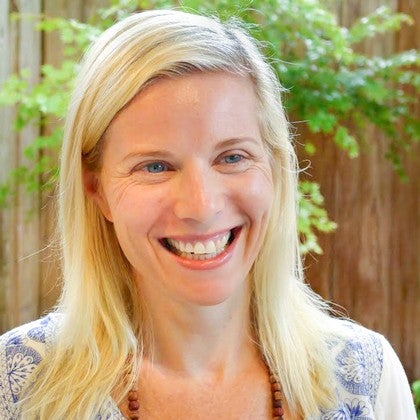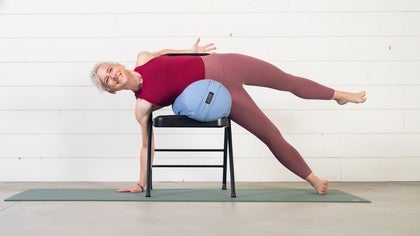
Yin Yoga and the Art of Letting Go
My first Yin Yoga class was with Sarah Powers - someone I now consider part of the triumvirate of Yin Yoga masters. A friend had given me her DVD years before my attendance but I barely watched it. The weekend workshop was in Savannah, Georgia - a few hours drive from my hometown - and the same friend that had given me the DVD persuaded me to join her for the weekend. I went begrudgingly.
The idea of some soft form of yoga where you just lie around made no sense to me. Who needed that? I had found all I needed from my form of yoga – sweaty, powerful, strong - and that required that I just keep excelling in the poses I was already “perfecting”: inversions, backbends, arm balances, and of course lots and lots of chatturangas.
I was young - a cocky, belly-top-wearing vinyasa teacher. I had so much to learn. I still do.
The first pose Sarah instructed us into was called Dragonfly. I sat wide-legged in a forward fold meant to stretch mostly the inner thighs, hamstrings, and low back. I got into the pose and thought, Easy. Couple of breaths and we’ll move on to the next... but the timer was set for five minutes.
Do you know how long that is for a vinyasa yoga junkie? I was used to five breaths.
In a room full of seasoned yogis, I wasn’t about to tap out. I held the pose defiantly at first, confident in my skills as an experienced yogi, but as the seconds trudged by, the position drifted into excruciation. Was this even yoga? I’d been practicing for over a decade at that point in my yoga-life and I had never felt anything like this.
My mind flooded with thoughts of how to get out of the pose – get out of the room, get out of the entire weekend workshop - and any attempt at using my go-to stronghold, the ujjayi breath, was fruitless. I was left defenseless. Vulnerable.
This astounded me. I had never been to this place in my body. I’d never been this...deep? Was that what it was? My inner thighs burned and I felt sweat forming on my brow, even as my body was motionless. The sensation (can I call it agony?) humbled me; disheartened me; scared me a little. I wanted to cry or scream, not so much from the discomfort but from the emotions welling up and surfacing. My mind roared. The limitations of my patience were incredibly visible to me in that moment.
In regards to yoga poses, I was evidently used to the strategy of get-in-and-get-out: safely, smoothly, calmly. Aesthetically, I had been told my yoga was “pretty”. I’m sure my Vinyasa practice looked choreographed - like a dance. I took more pride in this fact than I realized.
But this...this Yin Yoga stuff was messy and disquieting and upsetting and there seemed to be nothing attractive about it. In fact, I felt repelled from this practice. Repulsed. Bewildered.
But I stayed. And basking in this agonizing and relentless stretch, I distinctly remember wondering, How has my current yoga practice never brought me here? Why has my yoga never shown me this?
It was ugly, but whatever I had unveiled, it was there.
Humbled by the slew of emotions a prolonged pull on my hamstrings could apparently invoke, I understood that whatever I was feeling could no longer be avoided. The entire practice was like shining a flashlight throughout my whole system and exposing the dark crevices that deserved “cleaning”. And as frustrating as this was, by giving my full attention to these concealed corners of my body, I felt a sense of relief and calm. I felt purified in both my mind and my body; rinsed clean.
This is one of the things I really love about Yin Yoga: it mimics reality because what you find when you clean isn’t always pretty, and you don’t always look pretty when you are in the act of cleaning. A Yin Yoga practice is not really Instagram worthy. You don’t do it for the glory or the photo-op. You do it for the fact that it develops compassion and gratitude and resilience.
Yin Yoga makes us soak in poses and take the time to explore and understand our physical boundaries. Because there is much more time in a Yin pose, students have the space to safely approach their edges and decipher where and when they can push beyond these limitations.
A fast-paced Vinyasa class is wonderful for a multitude of reasons (building strength and stamina, stimulating the lymphatic system, circulating the blood), but it is not best-suited for “playing the edge”. Playing at the edge of physical limitations - how far you can take a stretch; how long you can hold a pose - can lead to injury in a fast-paced class. But taking the time in a slow-paced Yin class to comprehend borders and push edges can lead to physical and psychological expansion.
Resist being deceived by the apparent stillness of a Yin Yoga practice. While the practice can look quiet-natured and serene on the outside, often there is a dichotomy between the outer stillness and the energetic, pulsating internal sensations of a pose. The practice of long pose holds stimulating specific target areas is not Gentle or Restorative Yoga.
Restorative Yoga is based on the premise that you have something that needs restoring: your physical health after an injury, surgery, or illness; your stress levels after a time of grief; your mental wellbeing after a traumatic experience. You require a gentle touch in these times. Restorative and Gentle Yoga use props to quite literally bolster you up so that you feel held, supported, and coddled.
Yin Yoga, on the other hand, assumes that you are healthy and that you are simply trying to improve or maintain your current level of health. Yin Yoga uses props not necessarily to make a pose more comfortable, but to help you achieve the target area and get the appropriate stretch. Yin Yoga can have a relaxing effect overall (this has to do with “the rebound” which is a term and a topic for another day), but most likely, during the actual holding of a pose for minutes at a time in a Yin practice, you will not feel relaxed. In fact, I often feel frazzled.
But I feel that this is the point.
The frazzled feeling I get from the discomfort I might feel in a Yin pose is a sure sign for me that the pose is working. By stimulating a certain target area or meridian we are helping the prana or chi of our system flow without restriction. The feeling is that the internal “electricity” or lifeforce (chi, prana) is calmed by the practice from a rushing, turbulent river to a smooth-flowing stream. Holding a Yin poses clears a dam where chi is blocked by tension and reinvigorates it where it may have pooled in the body like a stagnant swamp. Yin Yoga encourages the flow of chi. And when chi is flowing freely in the body, there is an overall sense of wellbeing; there is homeostasis.
Paul Grilley once said in a training, “An advanced Yin practitioner knows that the practice is a gradual overhaul of the nervous system.”
Yin Yoga eventually leads practitioners to become less ambitious about increasing range of motion and more excited about the energetic and mental refinement that a Yin practice can provide. Once a student breaks through the initial layers of tightness and tension in the body, he or she realizes that the practice has so much more to offer than just greater flexibility.
Mental chatter subsides and a sense of knowing and calm washes over a person practicing Yin. Sometimes this happens for students in the very first session; others may have to be patient until more muscular tension yields in the practice for the student to experience the deepest energetic effects of Yin. As our tissues yield and the body lets go, the tension of the mind seems to follow. And letting go feels incredibly liberating.
Words fall short of my gratitude for the experience of Yin Yoga. If you have practiced it long enough, I am sure you can relate. If you haven’t tried it, give a few sessions a try and tell me you don’t feel the magical relief of stillness.
Practice with Kate in Season 3 of Yin Yoga, only on Yoga Anytime.
Comments
You need to be a subscriber to post a comment.
Please Log In or Create an Account to start your free trial.









